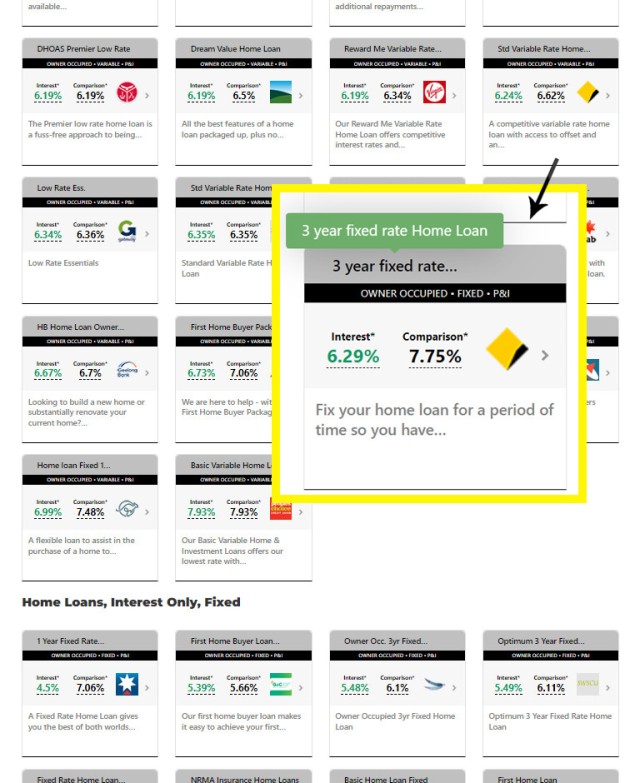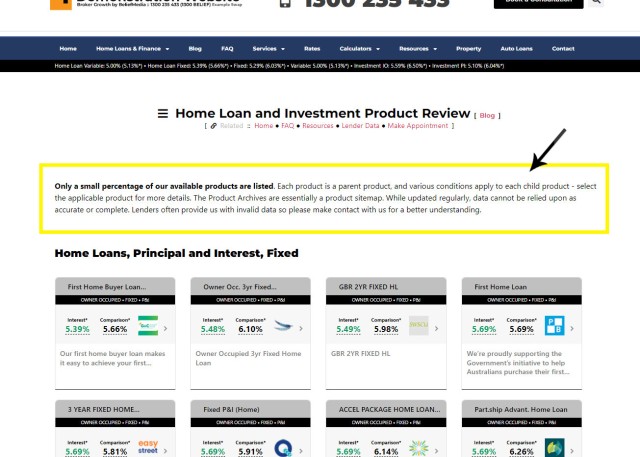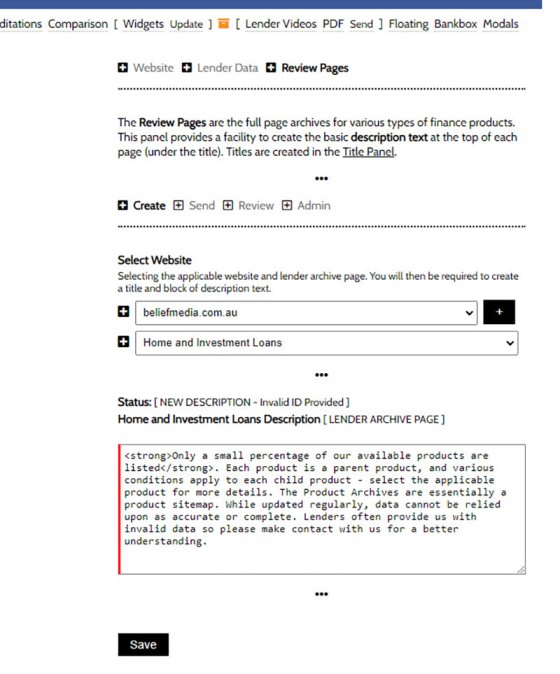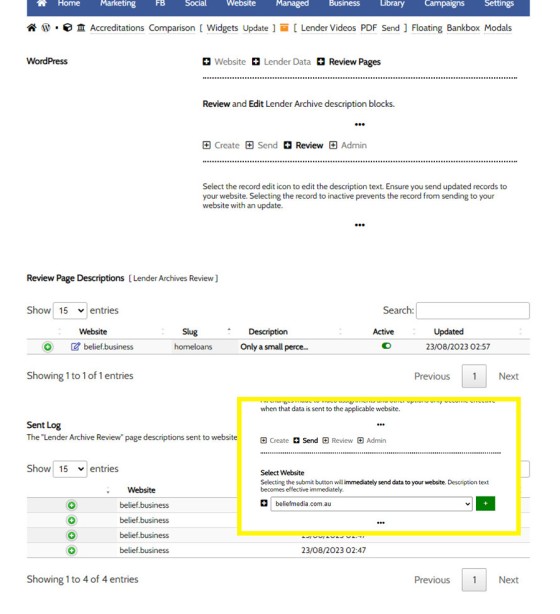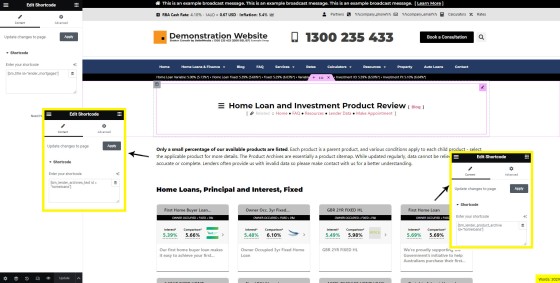We've said it over and over again, but we'll say it again regardless. You don't want to be a rate-driven broker, and you don't want to attract rate-focused mortgage customers. However, that doesn't mean that we selectively deliver self-serving information on our website or in the funnel at the expense of the information that well over 90% of borrowers are interested in seeing. Borrowers equate rates with savings, and not all of them are looking for that perfect structure or valuation that leverages their borrowing position... they just want to see the lowest rate.
Lender Data: As evidenced by the growing list of Lender-related FAQs at the bottom of this page, we provide a large number of lender options, and most internal website pages include the Lender Widgets that effectively act as kindle for a stagnant funnel.
We've introduced the Lender Archive pages and Lender Library in other articles. This FAQ will look at the purpose of the FAQ Lender 'Lowest' Archive, and show how to alter the introductory text at the top of each page.
Website Framework: The Lender 'Lowest' Archive was introduced in version 3.4 of our standard website framework, and version 1.7 of the older Platinum framework. If you don't have the archive pages, you will find brief instructions no how to include the feature into your site.
The Result
In newer frameworks, we use a number of BM Boxes on the primary 'Resources' archive page as navigation elements that link to the various lender pages. The purpose of the pages are to list the lowest rate for each product type from each lender, so we'll only include a single product for Commbank, one for ANZ, one for Westpac, and so on. The purpose of the page is to visually paint a picture of the range of rates of each product type (listed in order of rate).
Pictured: Selecting any specific product from any archive will direct the user to a product page that lists a large number of product details. When able, we'll embed or link to product PDFs although this may be muted in Yabber.
Pictured: A small extract from the Home Loan and Investment Archive. The Home Loan and Investment archive can be particularly long. The idea is to provide authoritative proof of your product claims and expertise - it's not to guide clients into any particular product. Note that each of the lenders in the screenshot is different, with each panel linking to the applicable product page. Archives are cached for up to 48 hours before replaced with new data.
In total, there are ten 'backend' archive pages that return content of the following types:
- Review Home & Investment Products
- Review Business Finance Products
- SMSF Product Review
- Personal & Auto Finance Review
- Green Finance Product Review
- Credit Card Product Review
- Margin Finance Review
- Overdraft Facility Review
- Term Deposit Archive
- Transactional Account Review
Remember, the ten archives listed above - unlike the two primary archives - are more of a navigation sitemap than any kind of usable resource, and they'll be used in the funnel to reinforce concepts rather than define them.
The one page that isn't listed above is the Lender Document Page, and this page lists every available PDF or other document made available via Lenders (example page here). It was previously excluded from all navigation menus but from Version 3.9 of our website framework it is now included by default.
Changing the Lender Lowest Archive Text
At the top of each Lowest Archive page is a title and block of text. The title is altered (if required) by way of the Titles Module, and the lower block of introductory text may be altered in Yabber. The text is applied by default, so it only needs to be altered if required.
Pictured: At the top of each Lowest Archive page is a title and block of text. The title is altered (if required) by way of the Titles Module, and the lower block of introductory text may be altered in Yabber.
To change this text, we'll first navigate our way to the Lender Module (within the 'Website' module) by selecting the small Lender icon. Selecting this option returns most Lender options. We'll then select the small and somewhat obscure 'Archive' icon in the submenu (the size of the icon gives you an idea of the importance of the feature).
Pictured: We'll first navigate our way to the Lender Module (within the 'Website' module) by selecting the small Lender icon. Selecting this option returns most Lender options. We'll then select the small and somewhat obscure 'Archive' icon in the submenu.
The icon returns a page where we may alter each of the standard blocks of archive text. Select your website and the archive page, and then populate the textarea with the necessary text. You may include shortcodes or HTML.
Pictured: The icon returns a page where we may alter each of the standard blocks of archive text. Select your website and the archive page, and then populate the textarea with the necessary text. You may include shortcodes or HTML.
The red margin on the textarea indicates that no value exists for the selected archive page. A green border is applied if editing an existing record.
Updating and Reviewing Archive Text
When an update of the data is required, we select the destination website and send. Updates are applied immediately. To review or edit any text block, select the 'Review' panel and select the edit icon located alongside the applicable record. The green icon returns an accordion panel with text attributes.
Pictured: When an update of the data is required, we select the destination website and send. Updates are applied immediately. To review or edit any text block, select the 'Review' panel and select the edit icon located alongside the applicable record. The green icon returns an accordion panel with text attributes.
Updating Older Website Frameworks [ Advanced ]
Those that have older frameworks may include the necessary features by way of shortcodes made available  in the 'Admin' panel. If you're brave enough, and have a sufficient understanding of Elementor, you can create each individual page and then copy the title, text, and archive text onto the page.
in the 'Admin' panel. If you're brave enough, and have a sufficient understanding of Elementor, you can create each individual page and then copy the title, text, and archive text onto the page.
You should create the pages in the 'BM Lender  ' archive. Each page will include the three shortcodes notes above, and nothing else. Quite frankly, if you're considering this route, give us a call - we might rebuild your entire site with the updated framework, or perhaps these some other methods to include the pages. Sadly, the pages can't be pushed automatically because of the modifications you have invariably introduced to your website.
' archive. Each page will include the three shortcodes notes above, and nothing else. Quite frankly, if you're considering this route, give us a call - we might rebuild your entire site with the updated framework, or perhaps these some other methods to include the pages. Sadly, the pages can't be pushed automatically because of the modifications you have invariably introduced to your website.
Pictured: If the archive pages are not on your website, creating them will likely introduce a complexity that you will most likely choose to avoid. Most business will never touch their backend, so for most of you, introducing any update yourself is a seriously significant endeavour.
You will also want to include menu items within the 'Resources' menu. We recommend using the BM Box.
■ ■ ■
Related Lender Data FAQs
Related FAQs and features relating to Lender Data. The Lender features tends to touch most modules, so only primary FAQ modules are shown.
There are a large number of ways in which to return various heading content blocks on your website, such as headings, titles, statements, blocks - most of which are listed below this FAQ in the related section. However, these assets are usually used in the design of certain pages - most notably landing pages -… [ Learn More ]
You have a best interest duty requirement imposed upon you that essentially mandates you quickly communicate rate data to your clients - first when the board makes a cash rate decision, and then later when changes are made, or when repricing might be appropriate. Yabber provide a basic facility to create an RBA Cash Rate… [ Learn More ]
One of the features of Yabber that is less visible than others is the lender rate email signature. The signature is an image that may be used in an email signature to return the lowest rate of a specific type. Yabber provides links to the direct image and will also create a HTML link for… [ Learn More ]
All rate data returned via Yabber will automatically segregate the requested 'standard' products from those 'conditional' products, such as green finance or leveraged residential lending against a business product. In all cases where we've had feedback from users and the validity of rates was questioned, the product has existed and was entirely valid, but the… [ Learn More ]
In an FAQ titled How to Define and Send Lender-Specific Videos for the Lenders Archive and Product Pages we looked at how to assign videos to the Lender Product Archive and Pages on your website. Familiarity with the former module is required, as this FAQ will simply show you how to link directly… [ Learn More ]
In a previous FAQ we introduced how to define the single video for your website Lender Archive page. However, this is the top-level entry page that effectively acts as a conduit to the Lenders Archive Pages and the thousands of Lender Product Pages. Each of the specific Lender Archive Pages, and all of… [ Learn More ]
The Lender Archive Video is a single video shown on the entry Lender Archive Page. It is important for the purpose of amplifying funnel enthusiasm and introducing your website visitors to the purpose of the vast information archives you make available. The video should always include an appropriate call-to-action, appropriate disclaimers, and other helpful… [ Learn More ]
We've said it over and over again, but we'll say it again regardless. You don't want to be a rate-driven broker, and you don't want to attract rate-focused mortgage customers. However, that doesn't mean that we selectively deliver self-serving information on our website or in the funnel at the expense of the information that well… [ Learn More ]
There are a couple of dozen different ways to show Lender Data on your website, and the floating Lender Panel is just another one of them. The panel is also a feature that you're not likely to use. We'll often say that we have to serve information on our website that the consumer wants and… [ Learn More ]
The Modal Module made available in Yabber is an incredibly powerful feature that provides enormous flexibility in how and when we interrupt the funnel in order to provide appropriate course correction. The system is supplemented by a linking feature that permits you to link directly to any modal manicured within the system. In order to… [ Learn More ]
Lender Modals are popups shown based on the lender pages on your website. Each lender is assigned to a 'Lender Group' with a group consisting of a single lender or multiple lenders, and the defined modal will show when a user visits the specific lender archive product pages on your website. A default lender… [ Learn More ]
The inclusion of transactional account data on your website is important because it's part of a mortgage product that a consumer will interact with every single day. In terms of our compliance obligations, only those transactional accounts that are associated with lender products may be shown, and this effectively includes every transactional account made available… [ Learn More ]
Business Finance is an important part of your business model, and the lending is a gateway loan into typical residential lending. The business finance products made available on your website are sourced from your accredited lenders. This FAQ will details how to include a Business Finance Lender Widget anywhere on your website.
Business Finance Widget… [ Learn More ]
Personal Loans are a getaway into other types of lending, so it's something that your business shouldn't ignore. It's a common type of finance that is widely used, and one that takes very little time to process. Your website includes various pages for personal vehicle, maritime, motorcycle, caravan, aircraft, and other types of specific assets,… [ Learn More ]
Margin lending is a type of loan that allows you to borrow money to invest, by using your existing shares, managed funds and/or cash as security. It is a type of gearing, which is borrowing money to invest.
Compliance We've consulted with ASIC to determine if it's acceptable from a compliance perspective to include details… [ Learn More ]
Despite the ubiquitous industry rhetoric suggesting that sharing rates on your website will only attract 'rate chasers' (partially true, but outside the scope of this FAQ), the rate information shared on your website will objectively attract and convert more mortgage clients. Used in company with other Lender Rate features, your powerful website presence will quickly… [ Learn More ]
Despite the ubiquitous industry rhetoric suggesting that sharing rates on your website will only attract 'rate chasers' (partially true, but outside the scope of this FAQ), the rate information shared on your website will objectively attract and convert more mortgage clients. Used in company with other Lender Rate features, your powerful website presence will quickly… [ Learn More ]
A number of FAQs make reference to 'Lowest Rate Placeholders'. Placeholders are a string of text that is replaced in many blocks of text with the lowest available rate of a specific type from your accredited lenders. The placeholders shown below are in no way definitive - in fact, they're just one style of placeholder,… [ Learn More ]
The Lender Widgets on your website are one of your most powerful website features. Despite the ubiquitous industry rhetoric suggesting that sharing rates will only attract 'rate chasers' (partially true, but outside the scope of this FAQ), the rate information shared on your website will objectively attract and convert more mortgage clients. Used in company… [ Learn More ]
Quite frankly, the Lender Archive Page link shortcode is rather pointless because the standard link shortcode is arguably more effective. The reason it exists is because we have other plans for how the shortcode is to be used. So, if you're linking to a specific lender archive, such as that for the Commonwealth Bank  ,… [ Learn More ]
,… [ Learn More ]
The Lender Widgets on your website are one of your most powerful website features. Despite the ubiquitous industry rhetoric suggesting that sharing rates will only attract 'rate chasers' (partially true, but outside the scope of this FAQ), the rate information shared on your website will objectively attract and convert more mortgage clients. Used in company… [ Learn More ]
The Lender Library is an unusual page. It was once a hidden page on broker websites that was used almost exclusively by brokers. It has since become a standard public page within the website framework. The article in our blog titled "Mortgage Broker Lender Document and Media API, and Lender Documents Elementor Block" should be… [ Learn More ]
In order to represent your panel of lenders on your website, most brokers will use a silly slider of static images, and others will use a single fixed image comprised of multiple images - just a lazy solution. Your website includes a grid of images that links to the application Lender Archive Page that'll… [ Learn More ]
The Featured Product panel is a means to provide an array of information on a single product. The information may be shaped in numerous formats which is guided by the Elementor plugin options. As is expected from any finance professional, the rate data (and other product data) is always maintained to reflect the current rate.… [ Learn More ]
Like it or not (and most brokers don't), rates play a huge part in attracting the early attention of your website visitors. You will attract more traffic and you will attract more clients. What you do next will unlikely be rate focused, but our early efforts should be focused on creating conversations.
Note:
This FAQ provides… [ Learn More ]The Featured Rates Panel is one of nearly 30 tools used to render lender data and comparison information, and it is one of two panels used to return 'Featured' rate data in a manner similar to that which we're about to describe. The 'other' featured rate panel' is somewhat of a legacy Elementor-only feature.… [ Learn More ]
There's a Rate Ribbon on the front page of your website below the centre-fold block that presents the lowest rates of various types. The purpose of the ribbon is to position yourself as a broker, showcase your digital expertise, and create early funnel pathways. Each rate shown in the ribbon links to the relevant 
The single line rate bar is shown on the broker website framework by default as part of the header and in the centre of the front page. The purpose is to position yourself as a broker, differentiate yourself from the 'others', showcase lowest available rates from your accredited lenders, and create website pathways. This FAQ… [ Learn More ]
The Published versus Comparison Rate graph was created to support a single FAQ on 'What is a Comparison Rate', but the graph often finds value elsewhere. To include the graph on your page, use the shortcode of [comparison_interest_faq]. The Result:
The graph simply illustrates how the published rate is often vastly different to the… [ Learn More ]
There are times where you will need to return the current cash rate into your website (often in your website footer as a quick reference). The shortcode of [bm_cashrate] will return 4.10% (bolding is ours). Simple. Note that the current cash rate is always shown in the header of your website. This panel links to… [ Learn More ]
All queries to lender data is measured against your accredited lenders. Once our accredited lenders are defined in Yabber, all queries from each of your specific websites will only return data from those lenders as defined in Yabber. Lenders are added to the system regularly and data is generally updated daily. Access the Lender Data… [ Learn More ]



